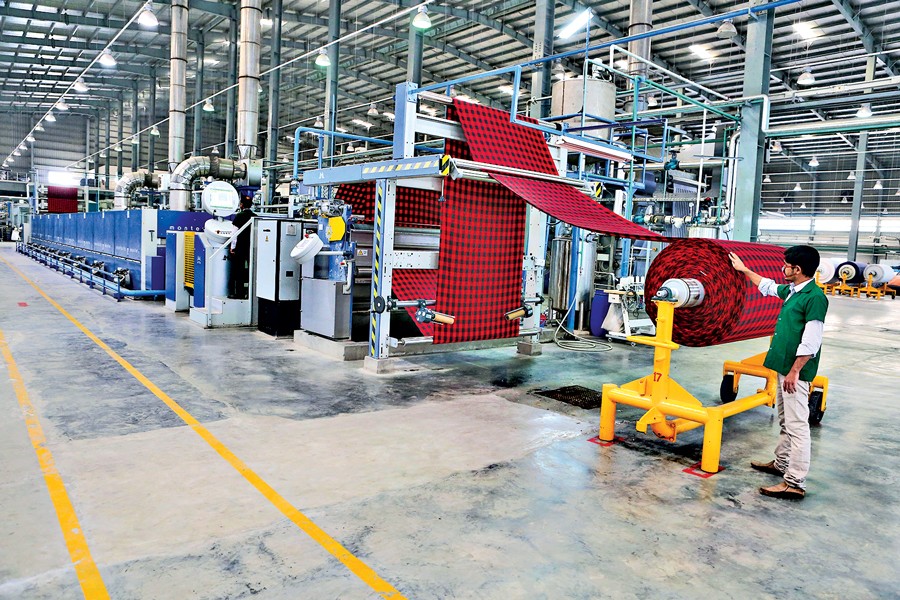 A worker mans a production line at a local mill. — FE Photo
A worker mans a production line at a local mill. — FE Photo  Bangladesh has gone through a rapid urbanisation in the last two decades though this did not follow a planned pathway and as such the development of the urban centres has failed to support the industrialisation process. The country's industrial sector is still to develop properly and supports a small share of the country's total workforce. Accelerated pace of industrialisation will, therefore, be necessary to address the diminishing capacity of agriculture to absorb the increasing labour force, to strengthen backward and forward linkages with agriculture and services sectors, to cater to the growing domestic demand for industrial goods, and to take advantage of emerging opportunities in the global market. However, the key question is - what can be done to achieve this?
Bangladesh has gone through a rapid urbanisation in the last two decades though this did not follow a planned pathway and as such the development of the urban centres has failed to support the industrialisation process. The country's industrial sector is still to develop properly and supports a small share of the country's total workforce. Accelerated pace of industrialisation will, therefore, be necessary to address the diminishing capacity of agriculture to absorb the increasing labour force, to strengthen backward and forward linkages with agriculture and services sectors, to cater to the growing domestic demand for industrial goods, and to take advantage of emerging opportunities in the global market. However, the key question is - what can be done to achieve this?
One possible way of attaining this is through diversifying the manufacturing system. Presently, the textile and readymade garment sector employs about 6.5 million people and accounts for over one-half of manufacturing production. Diversification of manufacturing production and exports will ensure sustained growth and employment creation. At the same time, initiatives will be needed to strengthen small and medium scale enterprises, as well as to create conditions for raising productivity and competitiveness of large-scale manufacturing industries to enable them to compete on global and domestic markets. This will necessitate a broadening of the industrial base by creating a conducive environment for private sector investment, through targeted initiatives towards technology transfer, upgraded skills and development of appropriate human resources, development of knowledge-based industries and by raising labour and capital productivity at the enterprise level. Rationalisation and restructuring of the state-owned enterprises (SoEs) will need to be continued so that strategically-placed SoEs can run profitably on a commercial basis, and others are handed over to the private sector.
Manufacturing is the predominant and leading sector within broad industry, which also includes such activities as power generation, water and sewage, and mining and quarrying. Manufacturing is and will remain the driver of industrial growth and employment for the years to come. The target of attaining an annual GDP growth rate of 10 per cent requires improved double-digit performance for manufacturing taking its share in GDP to 28 per cent by 2021, and that of industry to 37 per cent.
In view of emerging opportunities on the global market, and through making the best use of the preferential market access treatment offered to Bangladesh, initiatives should be taken to ensure competitiveness of potential labour-intensive manufactures beyond textiles and RMG or leather goods, into products such as toys, agro-processing, auto parts, electronics and light engineering. This requires the government to revisit its policy priorities and make necessary adjustments through developing an understanding of the current capacity of the manufacturing sector.
In addition to that, emphasis should be placed on small and medium enterprise (SME)-based industrialisation that will be labour-intensive, spatially decentralised, users of indigenous raw materials, and will be serviced by adequate human resources and technology adoption and transfer. The aim should be to cater to the growing domestic market, and to enable SMEs to be linked up with foreign markets through a package of support including credit, common services, upgrading of skills and institutional support. The SME strategy should build a network with the short gestational and highly job-intensive micro and small industries in the agro-based, poultry, livestock and fish-related projects, which aim to produce balanced fertiliser, biogas energy, milk products, poultry products, handicrafts, and horticultural goods for markets at home and abroad.
Policy support and promotional initiatives should be put in place to realise emerging opportunities in the "thrust sectors" as identified in the Industrial Policy 2010 and 2016. These include ICT-based sectors, food, beverages, light engineering, high-end readymade garments, pharmaceuticals, ship-building and other sectors. Export incentives such as bonded warehouse facilities, duty drawback, and infrastructural support in the form of establishment of industrial parks, dedicated private sector export processing zones (EPZs) and special economic zones (SEZs) should be put in place to stimulate their growth.
At the same time, for effective technology transfer and to ensure a ready flow of capital, the significance of foreign direct investment (FDI) cannot be denied. The FDI may also play an important role in increasing the skill-set, which is critical to getting an edge in the competitive global market. Considering these factors, FDI should be encouraged through various policy incentives to stimulate access to technology and frontier knowhow, to access global market opportunities and to take the advantage of the growing regional market.
The target with regard to the external sector is to strengthen global integration of the Bangladesh economy by building necessary trade-related supply side capacities. This should be realised through raising the competitiveness of Bangladesh's exports, ensuring a larger share for the country in the global trade in goods and services, and by encouraging both product and market diversification. Bangladesh's strong performance in the global labour market should be continued and further consolidated. The overarching goal here should be to ensure that trade-GDP ratio rises to nearly 60 per cent of GDP with export of goods and remittance earnings approaching 40 per cent by 2021.
The discussion above shows not only the challenges facing the manufacturing sector but also indicates possible actions that should be taken by the government of Bangladesh. The role of the government in expanding productive capacity of the industrial sector can, however, be summarised in the following points -
* To re-examine and modify the policy priorities of the government regarding the manufacturing sector and to find out new avenues while taking under consideration the existing capacity of the private sector;
* Increasing capacity of the bureaucracy while keeping in mind that in order to improve the performance of the industrial sector, a collaborative effort is essential. This collaborative effort can be materialised through an effective public-private partnership, which will consider not only the political reality but also the concerns of the private sector entities;
* To work in collaboration with the private sector in order to identify areas which will help the business entities flourish and to provide necessary support and incentive to the private sector in making them competitive in the international arena;
* To put more emphasis on SME-based industrialisation;
* Export incentives like bonded warehouse facilities, duty drawback, and infrastructural support in the form of establishment of industrial park, dedicated private sector EPZs and SEZs should be put in place to foster the growth of the thrust sectors.
The writer is a Professor and Chairman, Department of Development Studies and Director, Centre on Budget and Policy, University of Dhaka. [email protected]
© 2024 - All Rights with The Financial Express
